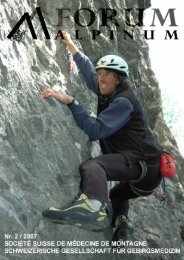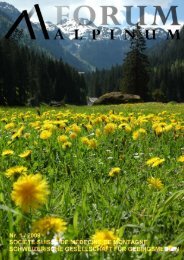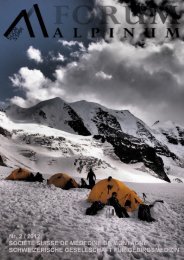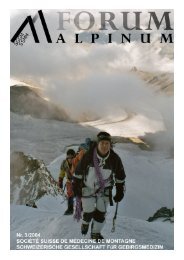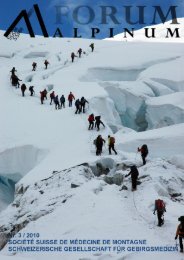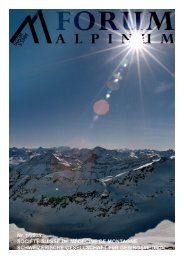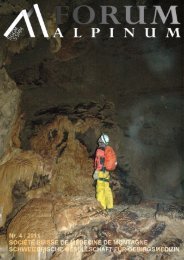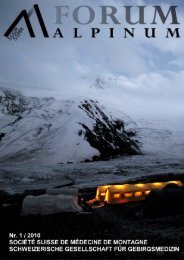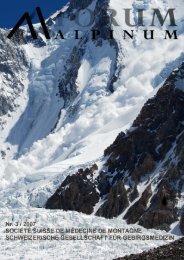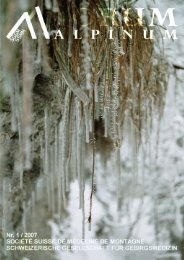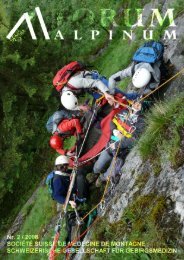abstracts 2010 - Schweizerische Gesellschaft für Gebirgsmedizin
abstracts 2010 - Schweizerische Gesellschaft für Gebirgsmedizin
abstracts 2010 - Schweizerische Gesellschaft für Gebirgsmedizin
Sie wollen auch ein ePaper? Erhöhen Sie die Reichweite Ihrer Titel.
YUMPU macht aus Druck-PDFs automatisch weboptimierte ePaper, die Google liebt.
3. DISCUSSION<br />
3.1 Problems with risk matrices<br />
As previously mentioned there are problematic<br />
mathematical properties of risk matrices.<br />
For instance they can assign identical ratings to<br />
quantitatively very different risks. Inputs to risk<br />
matrices require subjective interpretation, and different<br />
users may obtain different scores for the<br />
same quantitative risks. The limitations suggest<br />
that risk matrices should be used with caution, and<br />
only with careful explanations of embedded judgments.<br />
For instance it will often be necessary to<br />
state that a maximum score on one particular factor<br />
overrides all the others, or just stating that the<br />
method is not applicable in extreme situations.<br />
Another statement that often would be included is<br />
that when there is a very high uncertainty about<br />
one risk component, this should automatically receive<br />
a maximum value.<br />
The simulation approach is promising as it<br />
eliminates some of the shortcomings of the matrix<br />
and is a better way of optimizing decisions under<br />
uncertainty.<br />
3.2 Upper bound risk level for rescuers<br />
As it happens, the statistics of accident<br />
rates for alpine and avalanche rescuers are greatly<br />
lacking. For general rescue work, some numbers<br />
are available, mainly from the USA. Death<br />
rates amongst US emergency personnel stand at<br />
12.7/100000, police at 14.4/100000, and fire fighters<br />
at 16.5/100000 workers (Maguire, et al., 2002).<br />
Case fatality rates for alpine rescue are not available<br />
and this is something we would like to propose<br />
as a task for further investigations.<br />
Although the concept of "acceptable risk"<br />
is not well-defined outside the context of<br />
cost/benefit assessments, there seems to be good<br />
reason to set an upper bound. Werner Munter<br />
(2003) asserts that a case fatality rate of 1/100000<br />
is within an acceptable domain for mountain ski<br />
touring and guiding. This is among other things<br />
justified by the societal acceptance of road transport<br />
which has a similar case fatality rate.<br />
4. CONCLUSION<br />
Starting from the “romantic heroism”,<br />
which is to some degree probably still present in<br />
rescue organizations, it has been a long way towards<br />
quantitative risk analysis and decision making<br />
that is transparent and ethically defensible,<br />
especially when used in hindsight. A risk/benefit<br />
matrix is a first step towards this and the simulation/optimization<br />
approach holds promise.<br />
Although a simulation is never perfect, it<br />
has the capability to filter out many of the most<br />
tragic situations that lead to severe injury or death<br />
of fellow rescuers in the past. Furthermore, the<br />
tool has a major effect on the awareness of rescuers<br />
and rescue leaders towards recognizing an<br />
acceptable risk / benefit balance and its contributing<br />
factors.<br />
The authors hope to contribute to the reduction<br />
of severe accidents in avalanche rescue<br />
missions and hope to be able to further develop<br />
the strategies and tools in the future.<br />
5. ACKNOWLEDGEMENTS<br />
The authors would like to thank Joe<br />
Myers, CSP, MPH, US Coast Guard Headquarters<br />
for bringing to our attention the work being done<br />
by the USCG, and the NRC-SAR avalanche resource<br />
group and it’s leader Albert Lunde for valuable<br />
input and discussions.<br />
6. REFERENCES<br />
Bore, B.K. 2002, Redningsmannskaper anmeldt,<br />
article in Norwegian newspaper Dagbladet,<br />
30.07.2002<br />
Falk M, Brugger H, Kastner L. 1994. Avalanche<br />
survival chances. Nature 368:21 (1994)<br />
Kristensen, K. 2004, 2007. Risk a Life to Save a<br />
Life? ICAR 2004, 2007 Avalanche Commission<br />
presentation (unpublished, web<br />
version available on Canadian Avalanche<br />
Association / Knowledge Centre / Research<br />
and Articles )<br />
Maguire BJ, Hunting KL, Smith GS, et al. 2002.<br />
Occupational fatalities in emergency<br />
medical services: a hidden crisis. Ann<br />
Emerg Med 2002; 40:625–32.<br />
Munter, W. 2003. 3x3 Lawinen, Risikomanagement<br />
im Wintersport, Verlag Pohl &<br />
Schellhammer<br />
US Coast Guard, (undated) U.S.C.G. Aviation<br />
Risk Assessment<br />
http://www.uscg.mil/SAFETY/pdf_files/Avi<br />
aitonRiskManag.pdf



